The Extraordinary Story of the Only German U-Boat to Reach the Pacific Ocean
It was U-862 of the IXD-2 series, such boats could travel 23,700 miles at 12 knots, which is 2000+ miles more than the length of the equator, dive 230 meters and carry 24 torpedoes on board.
But first, about its commander Heinrich Timm, because not everyone was awarded the Knight’s Cross, and he also had a hand in the defeat of convoy PQ-17, which we will certainly not forget him
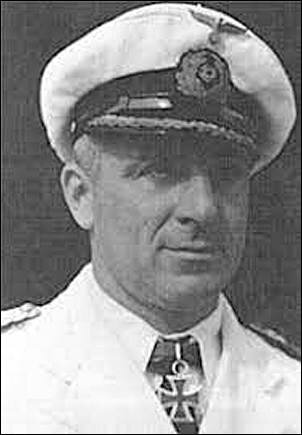
And he might not even have become an officer. Here’s the thing – each set of Kriegsmarine cadets was called a crew with a number of the year of recruitment. For example, the Besatzung 32 is a crew of 32 years. And each crew underwent a long practice on a training sailing vessel. So, crew 32, of which Timm was a member, on the training ship “Niobe” on July 26, 1932 got into the so-called “White Squall” in the Baltic
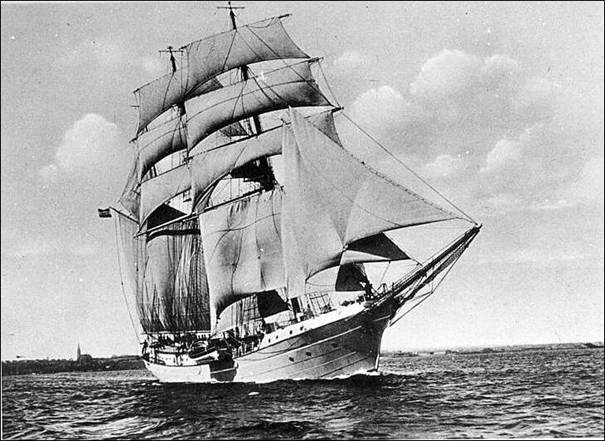
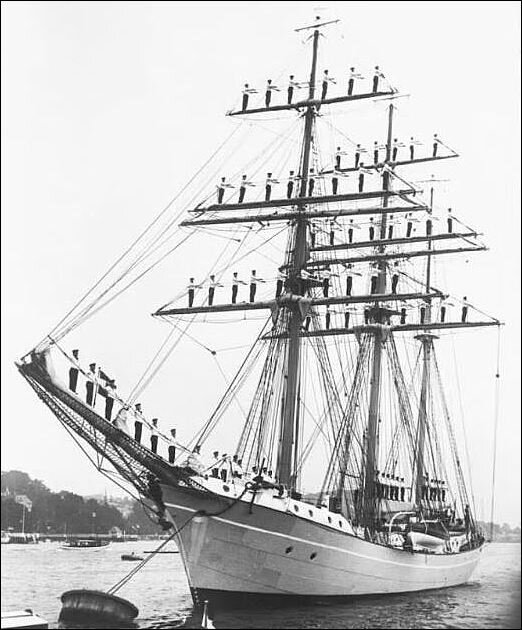
The ship capsized, in addition to part of the regular crew, 27 cadets were killed. Timm was among the 48 survivors. And here again the magic of numbers – out of these 48 people, 27 died during the war.
Initially, Timm, like the other aces – Prine, Luth or Hardegen, who was generally a pilot at first – served in the surface fleet. And he distinguished himself here. The British submarine HMS Starfish tried to attack the minesweeper M-7, which he commanded. Here is this boat on the Thames:
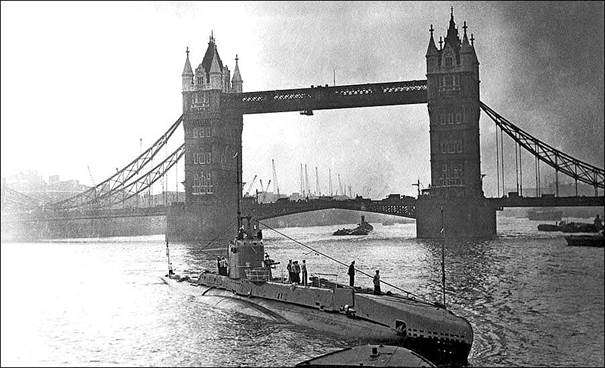
And here’s the minesweeper:

The attack failed, and in response Timm bombed it so much for several hours that the British were forced to surrender. Their entire crew was lifted out of the water by the Germans, and the boat sank.
After the capture of Norway, for which Timm was awarded the Iron Cross, he trained as a submarine commander and in September 1941 took command of the brand new U-251 series VIIC.
The submarine operated in the Arctic. On 3 May 1942, Timm finished off the transport Jutland from convoy PQ-15, which had been abandoned by the crew after an aerial bombardment, and on July 10, the transport El Capitan in the same circumstances from convoy PQ-17
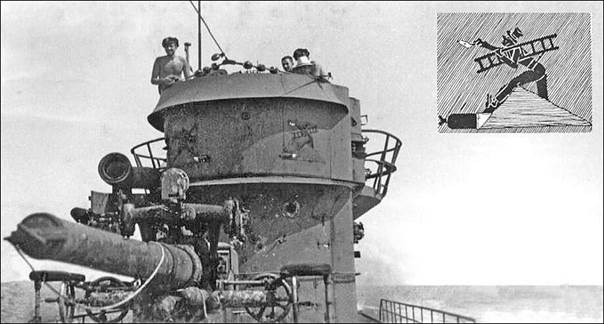
Here is the boat returning to Narvik on July 15 after this victory:
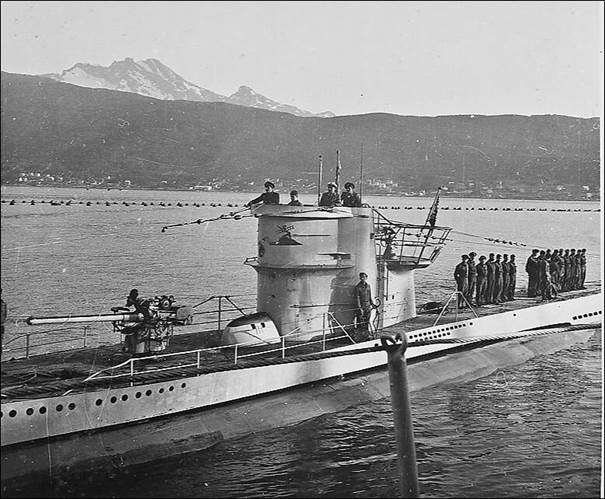
Timm also took part in Operation Wunderland in the Kara Sea, surfacing near Solitude Island and destroying a Soviet weather station with artillery fire from her deck gun. However, the radio station was not damaged and the seven polar explorers continued to transmit weather reports.
Timm had a habit of delighting the ears of the team with music on the broadcast, which not everyone liked, so he got the nickname Tüte – this is a cone-shaped bag, for example, for sweets, resembling the bell of a gramophone. This package with a torpedo sticking out of it became part of the emblem of the boat, which also depicts a chimney sweep bringing good luck:

Timm was really lucky. The crew learned to respect their commander as they discovered that he had no intention of needlessly sacrificing the boat or his men for personal glory; Never escaping combat, he always returned his boat to base undamaged.
U-251 was taken out of service for overhaul in June 1943, the experienced crew had nothing to do and was transferred to the new U-862.
On 21 May 1944 the submarine left Kiel with other submarines and an escort. U-862 carries various documents, models and drawings of German weapons and equipment for Japan. Its compartments are filled with flasks of mercury, ingots of lead, steel, raw optical glass and aluminum.
Timm calls at the Norwegian ports of Kristiansand, Bergen and Trondheim The crew discovers a leak in a fuel tank, and the boat is sent to Narvik for repairs. Caption: The boat leaves Trondheim on May 28, 1944.
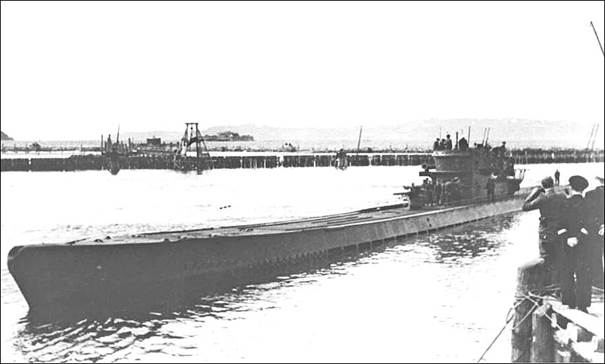
On 3 June, she left Narvik and headed south through the Denmark Strait. On July 25, in the South Atlantic, Timm sends the steamer Robin Goodfellow to the fish
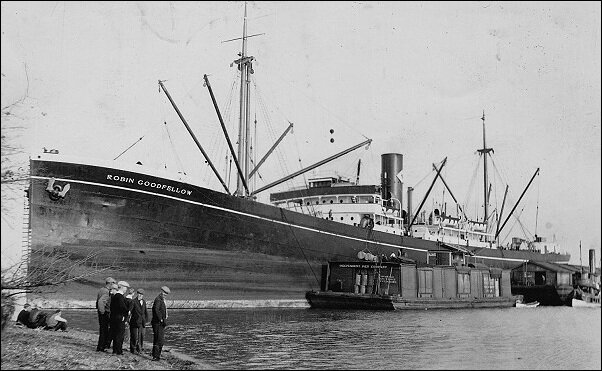
All 69 people on board were killed. On July 5, a radiogram arrives on the boat that Timm has been awarded the rank of Korvettenkapiten.
On 13 August, Radbury was sunk in the Mozambique Channel. On August 16, 30 of its crew and five gunners landed on the uninhabited island of Europa. Three sailors and one gunner left the island on a raft, but on November 1, only one of them reached Quelimane, Portuguese East Africa. The remaining survivors on the island were rescued on 27 October by the corvette HMS Linaria.
On August 16, the Empire Lancer was attacked
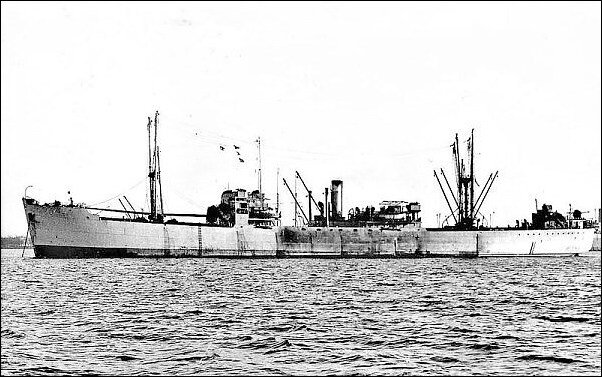
The captain, 36 crew members and five gunners were killed. The 34 crew members and three gunners reached the shore 60 miles south of Lumbo, Portuguese East Africa, ten days later.
On August 18, it was the turn of the steamer Nairung. The captain, 82 crew members and eight gunners were killed. The explosion was so violent that some submariners thought they had been hit by their own torpedo, and the wreckage had hit the submarine without damaging it.
On 20 August, the boat was raided by a Consolidated PBY “Catalina” from No. 265 Squadron RAF
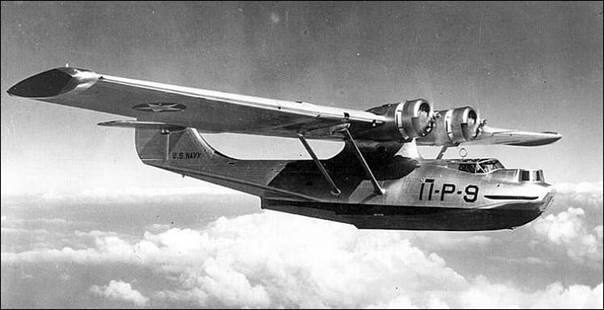
It was successfully shot down. Its size can be judged from this picture:
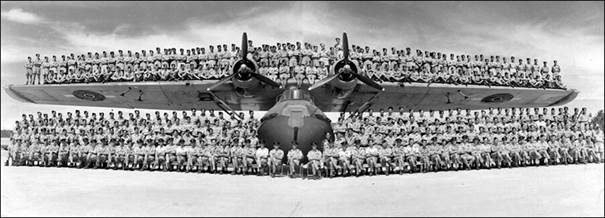
On 9 September 1944, the boat arrived at Penang:
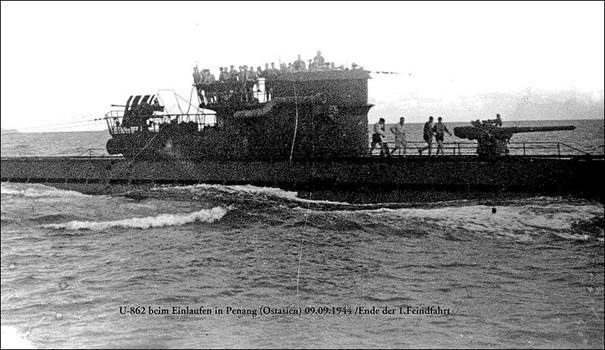
It was solemnly greeted by representatives of the German and Japanese commands. Reciprocal visits, banquets and all that. If only they knew what the future held for them…
On 19 September, it was reported that Timm had been awarded the Knight’s Cross. After arriving in the Far East, U-862 spent seven weeks undergoing repairs in Singapore and 10 days in Jakarta, giving the crew time for a short period of recuperation in the mountains
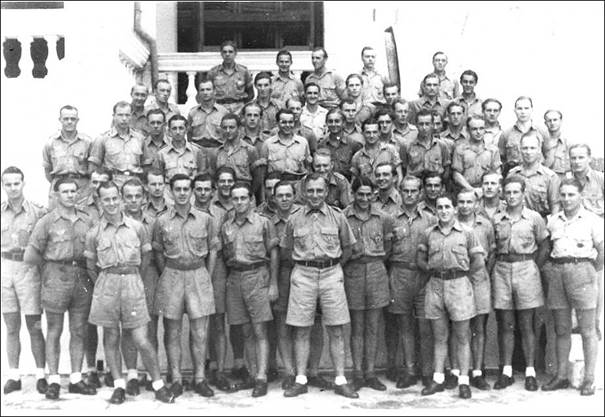
18 November 1944 U-862 departs from Batavia on combat patrols for Australia and New Zealand
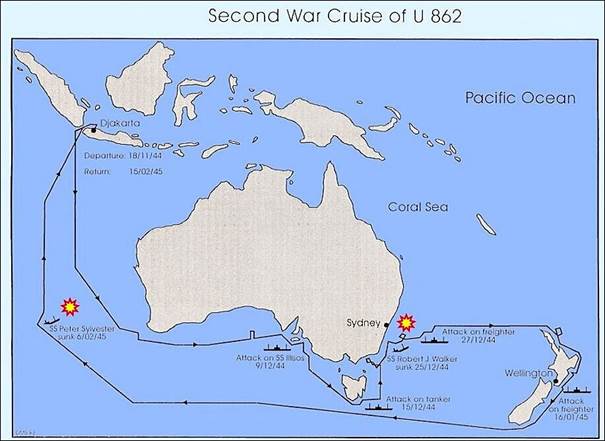
On December 9, 1944, the Greek tanker ILLISOS was encountered 130 miles southeast of Adelaide. Finding the ship too late for an underwater torpedo attack, Timm surfaced and ordered his 105 mm deck gun to be fired. In rough seas it was impossible to fire accurately, and since the tanker was also returning fire, Timm soon decided to abandon the attack.
Upon learning of the incident, the local command ordered two nearby Australian corvettes, HMA Burnie and Maryborough, to search for the submarine. The corvettes did not detect anything with their own sonars, but were counterdetected by U-862 hydrophones.Timm surfaced, but due to poor visibility, was unable to identify the warships and, as deteriorating sea conditions prevented a torpedo attack, decided instead to sail south at high speed.
On December 25, 1944, off Montagu Island, U-862 torpedoed the 7,180-ton Liberty-class ship ROBERT J. WALKER. Walker’s 20mm gun launcher detonates a second incoming torpedo, but Timm fires four more torpedoes and achieves two more hits. After the second hit, the survivors, including ten officers, 32 sailors, 26 armed guards (the ship was armed with one 5-inch, one 3-inch, and eight 20-mm guns), and one passenger left the ship in three lifeboats and four rafts. Two crew members were killed. The survivors were picked up by HMAS Quickmatch in about 24 hours.
The ROBERT J. WALKER was the only ship sunk during the war by a German submarine in the Pacific.
The first RAAF aircraft arrived in the area ten minutes after the last torpedo exploded, beginning an extensive hunt that lasted more than two weeks. Among the hunters were also several Australian and US warships from Sydney and the Royal Navy’s 4th Destroyer Flotilla, which put to sea from Melbourne. It was to be the largest and longest submarine hunt ever conducted off the coast of Australia. All searches were fruitless.
Meanwhile, Timm headed to New Zealand. Another cargo ship was spotted on the way. A good position for the attack was reached, but again a faulty torpedo failed. In an attempt to conserve his supplies, Timm fired only one torpedo tube, and the torpedo exploded prematurely 300 meters from the submarine. The transport escaped unharmed.
After crossing the Tasman Sea, U-862 rounded North Cape and sailed along the east coast of New Zealand. From time to time, Timm brought the submarine very close to shore; close enough to Gisborne and Napier to see cars in the streets and hear music from cafes. There were no worthy goals.
U-862 entered Gisborne Harbour on the surface at midnight on 15 January 1945, hoping to find anchored vessels, but found nothing. There was only a meter of water under the keel of the boat in some places, but everything ended well. In connection with this event, there is a story that the Germans landed on the shore near Napier to quietly milk the wandering cows, missing the milk. But, of course, this is only folklore.
With seven remaining torpedoes, Timm planned to return to the area off Sydney, but on 19 January 1945 he received orders to return to Jakarta immediately.
February 6, 1945, 700 miles southwest of Fremantle, Australia. At 22:40 local time, U-862 attacked the 7,176-ton Liberty-class vessel PETER SILVESTER, which was traveling alone from Melbourne to Colombo with a cargo of 137 Army trucks and supplies from the U.S. Army. The submarine fires 6 torpedoes, and despite its very survivable design, the ship is doomed
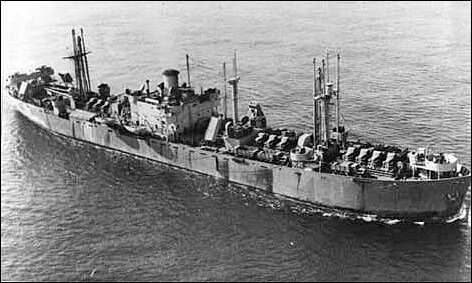
It was the last attack by an Axis submarine in Australian waters and in the Indian Ocean.
Those who survived on boats and rafts were part of the Allied ships for a month and brought ashore. Here are the ones found 22 days later by the escort carrier HMS Activity:
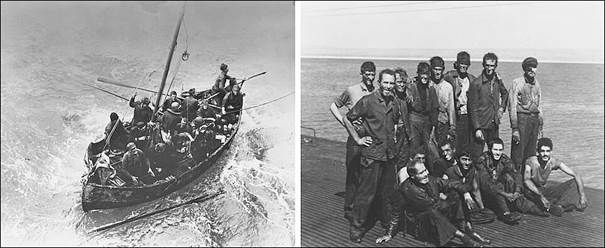
The submarine returned to Jakarta on 15 February, sinking just two ships with a total displacement of 14,000 tons in a three-month voyage. In his report on the hike, Timm explained the disappointing result:
The mistake in planning the operation was that the water area was too large. Better chances can be expected if you focus on traffic north and south of Sydney. The area would have repaid handsomely for a planned operation for a few boats.
On the other hand, despite the lack of results achieved, the voyage of U-862, traveling alone, farther from home than any other wartime submarine, should stand out as an epic achievement. By 1944, the average lifespan of a submarine at sea was just eight weeks. Despite the illness, boredom, extreme climate, frustration due to faulty equipment, and moments of real danger, Timm kept his team motivated and uplifted, even though everyone knew the war was lost.
20 February 1945, Singapore. U-862 arrives at Seletar Naval Base. Repairs begin. U-862, with 66% battery capacity, is expected to be ready for departure at the end of April. The submarine is to load as much rubber as possible and carry eight torpedoes for an interim operation off the southeast coast of Africa en route to the Atlantic. Berlin rejects the Japanese Navy’s request to land agents off the coast of Madras, India, on the way.
The formal unconditional surrender of German forces in all areas took effect at midnight on May 8, 1945. Two days earlier, Korvettenkapiten Timm had ordered the crew to assemble on board. Shortly before noon, a senior Japanese naval officer, Vice Admiral Shigeru Fukudome, and his staff arrived to inform the Germans of the imminent internment. In the afternoon, several trucks drove up to the wharf, And in front of the submarine, an armed detachment of Japanese soldiers was lined up. For a short time, it seemed to the Germans that the Japanese intended to capture U-862 by force. The situation, however, was under strict control, and within minutes the Kriegsmarine flag was lowered, the Rising Sun hoisted, and the submarine renamed I-502. There was no ceremony, and without a word the German crew disembarked and loaded into other trucks ready to transport him to their quarters.
U-862 was not used by the Japanese in combat and was discovered by the British in Singapore along with U-181 at the end of the war.On 15 February 1946, both ships were escorted by the Royal Navy frigates HMS Loch Lomond and HMS Loch Glendhu to the middle of the Strait of Malacca and scuttled at a depth of 52 fathoms.
The commander of U-862 and his crew survived the war. Timm later served in the German Bundesmarine after its formation in 1955, retiring with the rank of Captain zur See in 1966. He died in Bremen in 1974.
